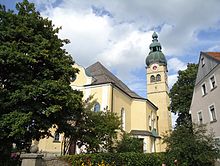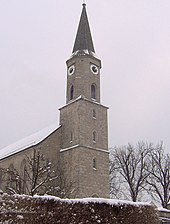Plößberg
| coat of arms | Germany map | |
|---|---|---|

|
Coordinates: 49 ° 47 ' N , 12 ° 18' E |
|
| Basic data | ||
| State : | Bavaria | |
| Administrative region : | Upper Palatinate | |
| County : | Tirschenreuth | |
| Height : | 600 m above sea level NHN | |
| Area : | 74.23 km 2 | |
| Residents: | 3220 (Dec. 31, 2019) | |
| Population density : | 43 inhabitants per km 2 | |
| Postal code : | 95703 | |
| Area code : | 09636 | |
| License plate : | TIR, KEM | |
| Community key : | 09 3 77 146 | |
| Market structure: | 38 districts | |
Market administration address : |
Jahnstrasse 1 95703 Plößberg |
|
| Website : | ||
| Mayor : | Lothar Müller ( CSU ) | |
| Location of the Plößberg market in the Tirschenreuth district | ||
Plößberg (Bavarian: Bläisberch) is a market in the Upper Palatinate district of Tirschenreuth . The state-approved resort is located in the east of the Upper Palatinate Forest Nature Park .
Community structure
The municipality of Plößberg is divided into 38 districts:
|
history
Until the church is planted
Plößberg was probably settled around 1052, the place was first mentioned in a document in the middle of the 12th century. After the Counts of Sulzbach, the noble family of the Plößbergs and the Gleißenthalers, lords of Schönkirch, Plößberg became the property of the Bohemian crown after 1350. After 1400 Plößberg, Schönkirch and Wildenau were Bohemian fiefdoms in Bavaria, and from 1506 parts of the Duchy of Palatinate-Neuburg . Several changes of ownership, wars and looting followed, especially during the Reformation and Counter-Reformation as well as the Thirty Years' War. In the Middle Ages, Plößberg was on the Golden Road from Nuremberg, via Bärnau and Neustadt to Prague. The Bohemian rights to the place were not declared null and void until 1805. Christian August von Pfalz-Sulzbach introduced the Simultaneum in 1652 , the equal rights in the use of the parish churches by Catholics and Protestants in his duchy, which was valid in Plößberg until 1918.
market
Plößberg Markt has been allowed to call itself since 1951 . Since then, Plößberg has also had its own coat of arms.
Incorporations
On January 1, 1972, the previously independent communities of Beidl, Liebenstein, Schönkirch and Wildenau were incorporated. On May 1, 1978, most of the community of Schönficht and parts of the area of the dissolved community of Hohenthan were added.
Population development
Between 1988 and 2018, the population stagnated or fell by 5 or 0.2% from 3,255 to 3,250. On December 31, 1998, the city had 3602 inhabitants.
politics
Market council
The market council has 16 members: After the local elections on March 16, 2014 , the council is composed as follows:
- CSU 9 seats
- SPD 4 seats
- Free voters 3 seats
mayor
The first mayor is Lothar Müller from the CSU.
coat of arms
The coat of arms shows four heraldic flowers (symbols of the Counts of Sulzbach) and a black and silver quartered shield (Lords of Gleißenthal).
Culture and sights
Museums
The Glass Melting Furnace Construction and Glass Museum is dedicated to the craft of manufacturing glass melting furnaces, which are and were indispensable for glass production .
The crib and home parlor in the town hall can be viewed.
Buildings
- Liebenstein flood reservoir
- Wildenau Castle in the Wildenau district
- Liebenstein castle ruins
- Plößberg Castle
- Parish church of the Assumption (Catholic) with Leonhardi Chapel in Beidl
- Expositurkirche St. Laurentius (Catholic) in stone
- Parish Church of St. George (Catholic) was built between 1916 and 1918.
- Parish church of St. Georg (Protestant) was built in the neo-Gothic style from 1854 to 1855 after the previous building was demolished.
- Chapel of St. Thaddäus was probably built in 1709.
Natural monuments
- Sulzteichstein in Beidl
sport and freetime
- Forest lido Großer Weiher
- Soccer team SV Plößberg 1946 eV
Plößberger cribs
The tradition of carving Christmas cribs and the associated figures was founded in the 19th century by the glass oven walls . They had gotten to know such nativity scenes during their activities in Tyrol, Bohemia and Thuringia and carved in Plößberg at home during the winter months. Today almost every house has its own crib, which is continued, supplemented and passed on over the generations.
Since 1970, numerous nativity scenes have been shown in a nativity show every five years. By 2010, more than 150,000 guests had visited the exhibitions. The crib show of 2015 took place from November 29, 2015 to January 10, 2016 in the ambience of a caravanserai . 37 nativity scenes were exhibited in landscapes made of natural materials up to over 20 square meters in size, some of which contained several hundred figures. The oldest nativity scene shown dates from 1800.
Economy and Infrastructure
The construction of glass melting furnaces has a long tradition in Plößberg. These are built worldwide by Plößberger furnace masons. The woodworking industry has also expanded significantly in the last few decades. There are several larger, medium-sized and smaller sawmills within the municipality.
The district of Liebenstein (Oberpf) is on the Wiesau – Bärnau railway line . This is shut down.
Web links
- Homepage of the Catholic Parish Plößberg - Schönkirch
- Aerial views of the market
- Entry on the coat of arms of Plößberg in the database of the House of Bavarian History
- Beidl.net Homepage of the village of Beidl in the municipality of Plößberg
- Plößberg: Official statistics of the LfStat
- Homepage of the 10th Plößberg crib show
- Homepage of SV Plößberg 1946 eV
Individual evidence
- ↑ "Data 2" sheet, Statistical Report A1200C 202041 Population of the municipalities, districts and administrative districts 1st quarter 2020 (population based on the 2011 census) ( help ).
- ↑ http://www.bayerische-landesbibliothek-online.de/orte/ortssuche_action.html ? Anzeige=voll&modus=automat&tempus=+20111108/160601&attr=OBJ&val= 1094
- ^ Wilhelm Volkert (ed.): Handbook of Bavarian offices, communities and courts 1799–1980 . CH Beck, Munich 1983, ISBN 3-406-09669-7 , p. 580 .
- ^ Federal Statistical Office (ed.): Historical municipality directory for the Federal Republic of Germany. Name, border and key number changes in municipalities, counties and administrative districts from May 27, 1970 to December 31, 1982 . W. Kohlhammer GmbH, Stuttgart / Mainz 1983, ISBN 3-17-003263-1 , p. 663 .
- ^ Website Plößberg, Wahlen






